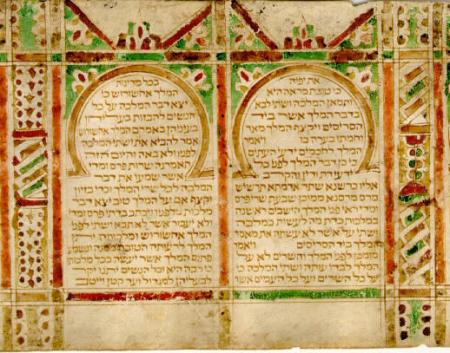Obj. ID: 11822
Hebrew Illuminated Manuscripts Unknown Collection Esther Scroll with Horseshoe Arches, Morocco, 19th/20th centuries

The ornamentation of the scroll is strongly influenced by Islamic art. The text of the Book of Esther is inscribed in panels topped with horseshoe arches. The text panels are grouped in pairs and every second panel is separated by a geometric pattern (they do not repeat in the scroll). The upper margins along with the membranes are filled with symmetrical ornaments. The first panel in the scroll is blank. In the second and last panels, initial and final benedictions are written.
To the right edge of the first membrane, a string or a ribbon is stitched.
The scroll is mounted on a wooden roller.
The color scheme featuring this scroll is typical for many decorated Jewish manuscripts from Morocco.
The decorations were sketched with the same ink as the text of the Book of Esther was written.
sub-set tree:
O | Ornamentation: | Ornament
O | Ornamentation: | Main text framed
A | Arch | Horseshoe arches
|
In the worst condition, the second membrane in the scroll is preserved. Other parchments are in good condition, although some slight damages of margins and decorations can be seen on them.
The Book of Esther in Hebrew is preceded by the initial benedictions and closed with the final benediction.
The scroll is formed of 4 sheets, containing in total 36 (?) columns of text of 18 or 19 lines each, except for the column including the names of Haman's sons which has 11 lines divided into two half-columns. Additionally, there are prefatory and final panels in the scroll.
The lines of the text fit the shape of the panels, therefore they are of different lengths.
The text is written in Hebrew square Oriental script in brown ink on the parchment membranes.
The ruling is made with a hard point but the lines are barely visible.
The pricking is invisible.
The membranes in the scroll are stitched together.
None
Formerly manuscript no. 081.012.022 in the Gross Family Collection.
No bibliography on the scroll is available.










